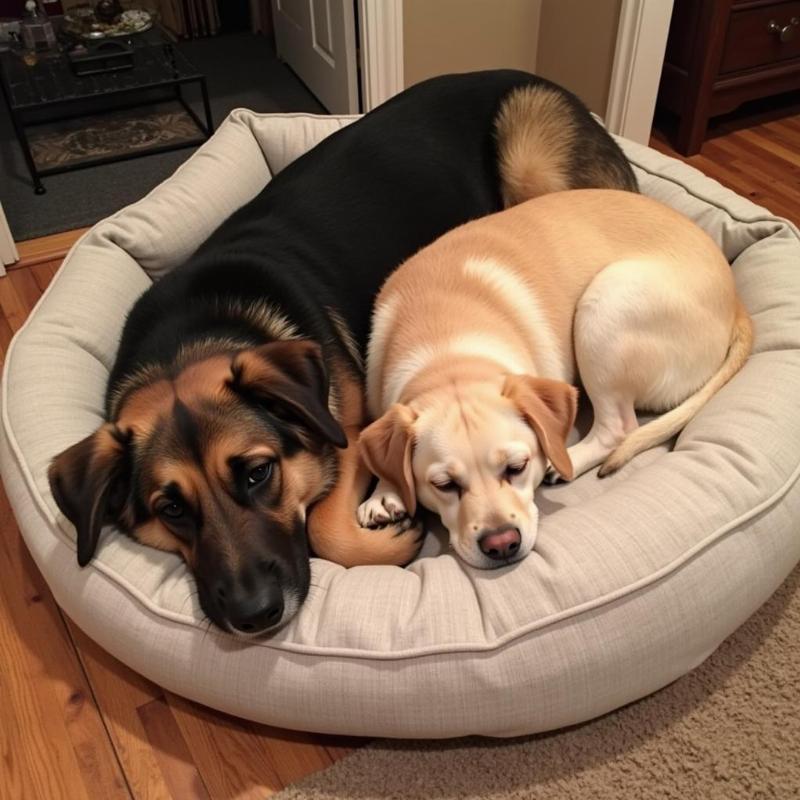Understanding the nuances of canine relationships can be fascinating. Many dog owners with multiple dogs wonder, “how to tell if dogs are bonded to each other?” Recognizing the signs of a strong bond can help you foster a harmonious multi-dog household and address any underlying tension early on. This article will explore the various behaviors that indicate a strong bond between dogs, offering practical insights and expert advice.
Recognizing a Canine Connection: Key Behaviors to Look For
Several behaviors can reveal the depth of the relationship between your dogs. These range from subtle cues to more overt displays of affection. Learning to interpret these signals will provide valuable insights into their social dynamics.
- Mutual Grooming: Dogs who share a strong bond often engage in mutual grooming, licking and cleaning each other, especially around the face and ears. This behavior not only reinforces their social connection but also helps maintain hygiene.
- Sleeping Close Together: Do your dogs often cuddle up together for naps? This close physical proximity demonstrates comfort and security in each other’s presence, a hallmark of a strong bond.
- Playful Interactions: Play is a crucial element in canine bonding. Look for signs of reciprocal play, where both dogs engage enthusiastically, taking turns to chase, wrestle, and bow. This balanced interaction shows mutual respect and enjoyment.
- Sharing Toys and Food: While resource guarding can be a common issue in multi-dog households, dogs who are bonded often share toys and even food without conflict. This demonstrates a high level of trust and comfort.
- Calm Coexistence: Bonded dogs often exhibit a relaxed and comfortable demeanor around each other. They may lie near each other without engaging in direct interaction, simply enjoying each other’s company in a peaceful manner.
- Checking In with Each Other: Bonded dogs often “check in” with each other throughout the day, making brief eye contact or approaching each other for a quick sniff. This behavior reinforces their connection and provides reassurance.
Subtle Signs of a Deep Bond
Beyond the more obvious behaviors, subtle cues can also indicate a strong canine connection. These often go unnoticed but can be just as telling.
- Mirroring Behavior: Dogs who are closely bonded may mirror each other’s body language and behaviors, such as yawning, stretching, or even lying in the same position. This subconscious mirroring reflects their deep connection.
- Shared Emotional Responses: Do your dogs react similarly to external stimuli, such as the doorbell or a passing car? Shared emotional responses can indicate a strong empathetic bond.
- Seeking Comfort in Each Other: When stressed or anxious, bonded dogs often seek comfort and reassurance from each other. They may huddle together or lean on each other for support.
 Hai chú chó ngủ cùng nhau
Hai chú chó ngủ cùng nhau
What if My Dogs Aren’t Bonded?
Not all dogs will form a deep bond, and that’s okay. While some dogs develop close relationships, others may simply coexist peacefully. Factors like personality, age, and individual history can influence their ability to bond. However, if you observe signs of tension or aggression, consulting a certified professional dog trainer or a veterinary behaviorist is crucial. They can provide tailored guidance and help you manage the dynamics of your multi-dog household effectively.
Conclusion: Fostering a Positive Relationship
Understanding how to tell if dogs are bonded to each other involves observing their interactions and recognizing both overt and subtle signs. While a strong bond can enrich their lives and create a harmonious home environment, it’s important to remember that every canine relationship is unique. By fostering a positive environment, providing appropriate resources, and seeking professional help when needed, you can ensure the well-being and happiness of all your canine companions.
FAQ:
- How long does it take for dogs to bond? It varies greatly, from a few weeks to several months, or even longer.
- Can dogs of different breeds bond? Absolutely! Breed has little bearing on their ability to form a bond.
- Is it normal for dogs to not bond? Yes, peaceful coexistence without a deep bond is also normal.
- What if my dogs fight occasionally? Occasional disagreements are normal, but consistent fighting requires professional intervention.
- Can I encourage my dogs to bond? Yes, providing opportunities for positive interactions, like playing together, can help.
- Do bonded dogs grieve the loss of a companion? Yes, dogs can experience grief and behavioral changes after the loss of a bonded companion.
- Should I be concerned if one dog seems overly attached to the other? While a close bond is good, excessive dependence can sometimes lead to anxiety. Consult a veterinarian or behaviorist if you have concerns.
Beautdogs.us is your premier resource for all things dog-related in the US. We offer expert advice on dog breeds, care, and products, catering to both novice and seasoned dog owners. Our goal is to empower you with the knowledge and resources you need to provide the best possible care for your furry friend. Contact us today to learn more! Email: [email protected], Phone: +1 501-555-7529. Visit Beautdogs.us for expert guidance on dog care, breeds, and products.